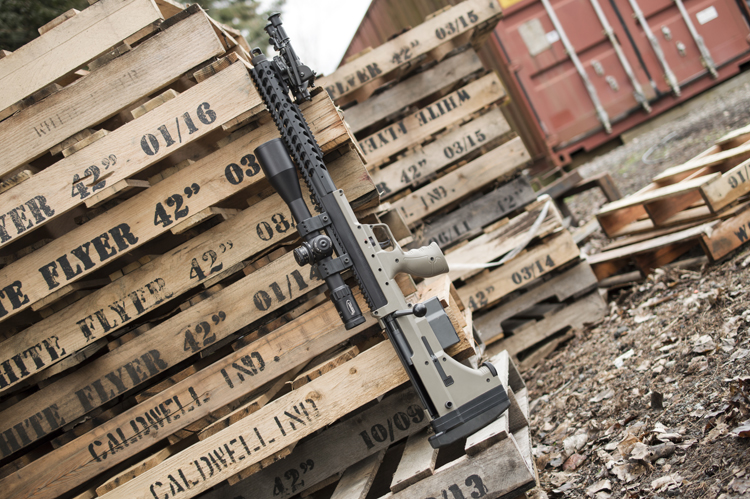
In case you’ve never noticed, although this publication works with writers and photographers all across the country, our head offices are located in the lovely corner of Canada known as the Pacific Northwest. In fact, we’re so close to the Pacific Ocean that if we ever get that giant earthquake our resident fault line promises, Calibre HQ will actually be under three feet of water. Not even kidding.
We love British Columbia and, as our license plates proudly proclaim, it is beautiful. With breathtaking vistas of soaring mountain peaks overlooking some of the most ruggedly beautiful coastline this world has to offer, it’s an outdoorsman’s dream, offering both world-class fishing and hunting. In fact, those of us living on the left, west, (best?) coast share our province with so much natural life and beauty that the tourism slogan is “Super, Natural British Columbia.”

And while this definitely makes hunting season a highlight for many, those of us that also enjoy shooting as a hobby unto itself can end up poring over Google Maps, Backroads Mapbooks, and forestry service websites trying to find new places to explore under the guise of looking for new shooting spots. A few hours outside of town in any direction, a couple hours up a forestry road, and however long you want to hike can take you everywhere from abandoned mining towns to craggy peaks offering sight lines all the way to Idaho and beyond (again, not even kidding).
Most of these trips involve a decent amount of walking up mountainsides, so we usually aim to pack as little as possible. In shooting terms, this means a robust precision-ish rifle and a few rounds of ammo, binoculars, and either paper or a steel targets to hang off a tree. Nothing fancy. To be more precise, we usually bring a mildly tuned Remington 783 in an MDT LSS chassis, with Vortex Viper PST. Why? Because it’s accurate enough to be fun, and if we end up slipping in a creekbed and dropping the thing, that very specific noise a gun makes clattering off rocks won’t hurt too much. We’d never really thought too much about it beyond that. At least we didn’t until the Desert Tech SRS showed up for testing.
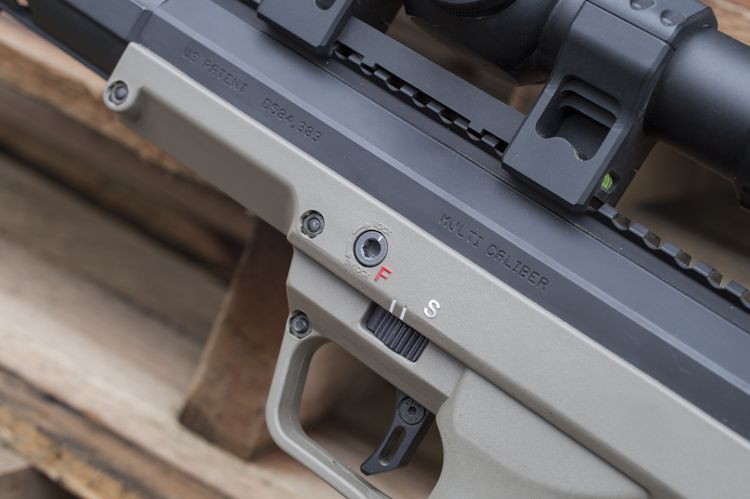
In case the pictures haven’t given it away, the Desert Tech SRS is a bolt-action precision rifle, rendered in a bullpup format. Like the Barrett M99 or the incredibly uncommon Keppeler KS V, this means the bolt cycles behind the pistol grip, and the chamber is just above or slightly behind the trigger shoe.
And while some Calibre staffers remain somewhat critical of the bullpup format in a modern semi-automatic rifle (probably due to simple familiarity with the conventional AR-15 manual of arms that’s been so drilled into us), there wasn’t anyone that didn’t think adopting a bullpup format for a precision rifle didn’t make sense; it shrinks what is normally a large-format rifle, balances far better, and due to the relative pace of fire and the ensuing magazine and control manipulations, gives up pretty much nothing to a “conventional” rifle even among those of us relatively unused to bullpup controls.
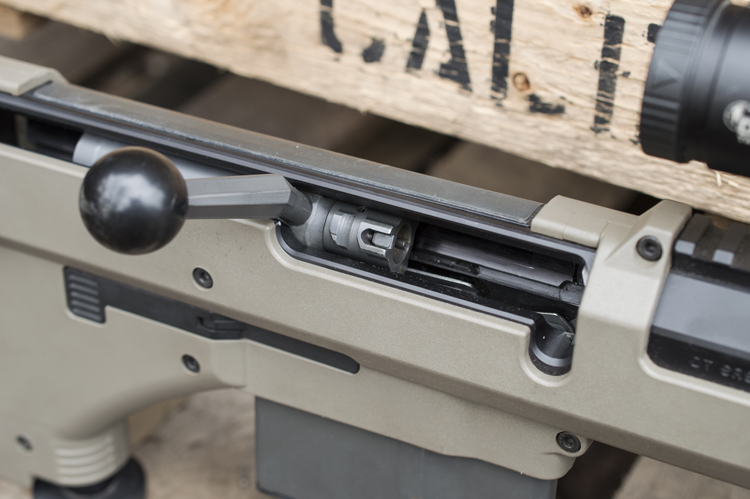
In terms of ergonomics, the same smart thinking that Desert Tech showed when they adopted the bullpup format is apparent in the overall simplicity of the gun’s controls and fit adjustments. Again, they didn’t invent good ergonomics any more than they invented the bullpup rifle, but their simple and clean execution of the notion deserves credit in a world rife with overcomplicated tactical designs. Take the pistol grip, for example. With a hearty swell and good finger grooves, it grips your digits like the perfect handshake, without any need for an adjustable palmrest. The stock, adjustable for length of pull, uses a simple system of spacers that slot into place and are retained with simple plastic tabs. And the cheekpiece; consisting of a soft but thin pad atop a metal riser, isn’t adjusted via some complex arrangement of pillars and thumbscrews…It’s just two allen-headed cap screws that tighten the cheekpiece against the stock once the desired height’s been achieved. And yes, left-handed versions are in production and available.
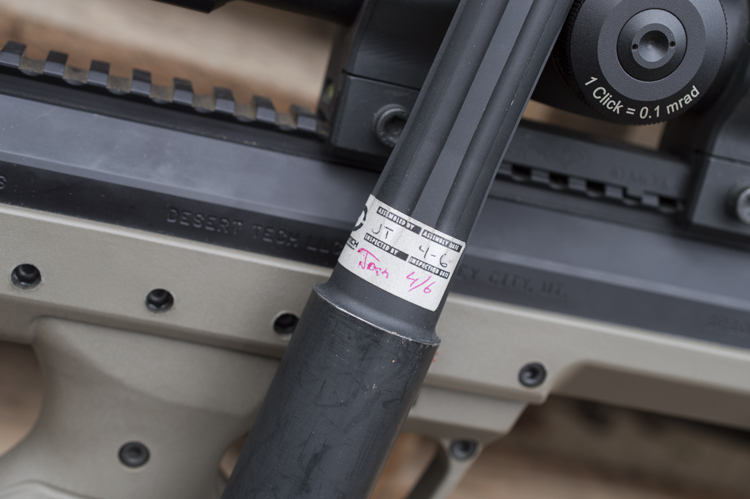
In terms of the manual of arms, we didn’t take nearly as much issue with the Desert Tech SRS as we do with the average bullpup, largely due to the simple fact that you don’t use the controls nearly as much. In other words, if you’re doing some practice drills with an AR-15, you might depress the bolt or magazine release a hundred times in a day, to say nothing of the number of times your safety will go from safe to fire and back. However, on a precision rifle, everything is much more civilized. In an hour’s shooting, you may only replace your magazine two to three times, and barely touch your safety. But, we’ll give the Desert Tech SRS credit. Its ambidextrous magazine release is quite handy and intuitive, although we did have some trouble with a tight-fitting .308 magazine. The sliding safety atop the trigger is about as good as we could ever ask, though, and the action, well, that’s a subject unto itself.
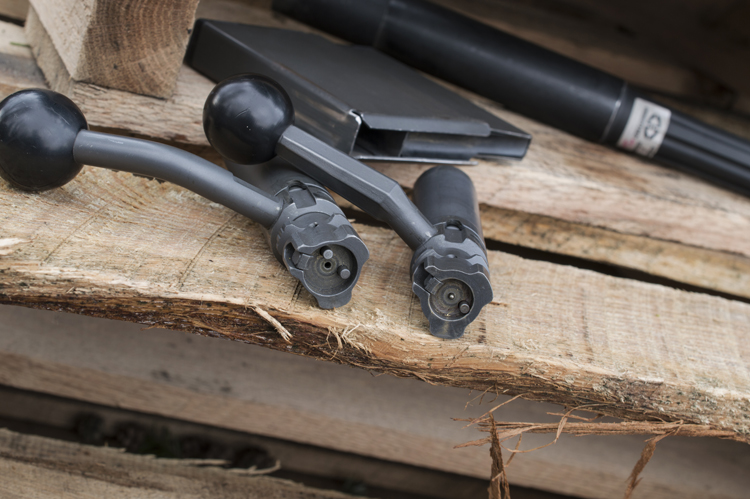
The action of the Desert Tech is nothing short of sublime. In order to assemble the rifle for shooting, it’s necessary to pull the recoil pad off the back, and insert the bolt. It’s then that one realizes how well made this largely polymer gun is. With so little exposed steel it’s a tough gun to judge at first glance, but when that tiny sleeved bolt slides into the perfectly sized action for the first time, it’s pretty obvious: This is where your money is going. It’s as tight as a bolt could possibly be without binding, and the nature of the bullpup’s action (insofar as it completely encases the bolt through the entirety of its travel) means there’s no bolt canting or tilting as it moves, making the whole operation feel fantastic.
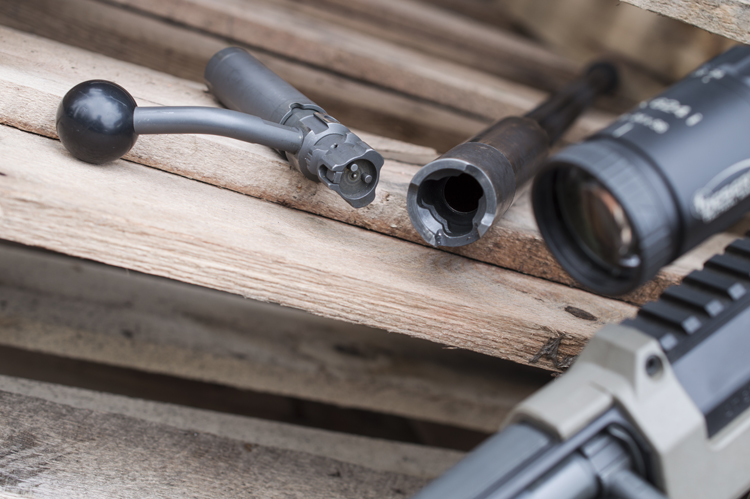
But waxing poetic about the action’s refined nature ignores the Desert Tech SRS' biggest party piece: The quick change barrel system. By turning the barrel retention lock screw to “unlocked,” and loosening a handful of screws, the action’s grip on the barrel tenon is released and the barrel can be easily pulled forward out of the action. Once accomplished, it’s apparent how simple the system is; the action is literally just clamped around the barrel. Of course, it’s much more complex than that in reality, as the machining tolerances of everything from the barrel tenon’s dimensions and the corresponding machined surfaces inside the receiver must mate perfectly. It’s also worth noting that this system also (obviously) incorporates an AR-15 style barrel/bolt arrangement in which the bolt locks directly into the barrel, rather than into the receiver. It’s the only way headspace can be maintained perfectly every time. Oh, and while we’re on the topic of the barrel, we’d be remiss if we forgot to mention that Desert Tech procures their barrels from none other than Lothar Walther; one of the most respected names in the business.
Shooting any serious precision rifle off of the comfortable shooting benches at our home club always feels a bit like cheating. Given most serious precision rigs are typically built to maximize the shooter’s effectiveness in far more demanding conditions, fiddling with the SRS’ various fit adjustments, bipod, and monopod heights all while quaffing a warm double-double in a heated shooting shack really doesn’t feel much like a test of such a gun’s capability. But, as easy as such conditions often make it, the flip side of near perfect conditions is a lack of excuses. Thankfully, the Desert Tech ensured we didn’t need any.
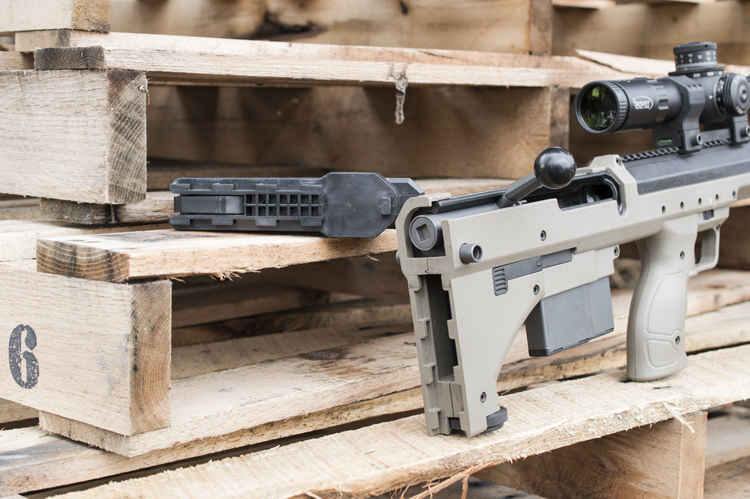
Now, I know that sounds like your standard gun writer hyperbole, but I would defy anyone that thinks we’re blowing smoke to shoot one for themselves and come to a different conclusion. The proof? With little to no special preparation, and shooting Barnes’ excellent .308 Winchester Precision Match load that comes topped with 175-grain OTM (open-tipped match) Sierra Matchkings, we managed to string together three unbroken groups that weren’t just sub-MOA, but rather substantially sub-MOA. The smallest measured just 0.59 inches across and the largest was just 0.81 inches. And again, we weren’t really trying all that hard. Obviously, yes, we did try and control our breathing and trigger control to the best of our ability, but we weren’t sitting there petting the barrel to try and check its temperature, nor were we really taking a ton of time—this gun is just crazy freaking accurate.
Three things contribute to the Desert Tech SRS inherent accuracy: The mechanical prowess demonstrated in its manufacture, the degree of comfort provided by the gun’s simple but effective adjustments and ergonomics, and the trigger. We’ve already covered the former two matters, but the trigger also deserves special mention because to have a trigger this good in a bullpup rifle deserves serious accolades.
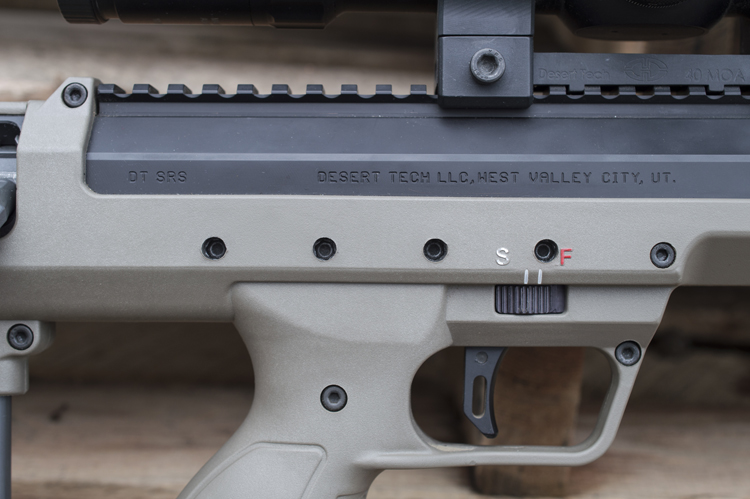
Why? Well unlike a normal rifle where the trigger can act directly on the striker or bolt assembly, bullpups move the trigger far ahead of the chamber and, as a result, the trigger must use a convoluted system of bars and pins to act upon the firing pin. In most cases, this system makes for a worse trigger. In the case of the Desert Tech SRS, it doesn’t. With a single-stage trigger that’s adjustable for creep, reach, and pull weight (between 1-3 pounds), it breaks just as well as any premium trigger in a conventional rifle. Set on the low end of the scale, ours was feather light, with absolutely no creep whatsoever—undoubtedly a big contributor to our success on the range!
The Desert Tech SRS is an unmitigated success. The rifle literally has no issues that we could identify. It shoots like a house afire, is easy to use, and finally provides the long-range enthusiast with a compact and relatively lightweight rifle. And with an (optional) super handy SKB custom soft case that even includes backpack straps, this is literally the perfect rifle for our crown land excursions. There’s even a pocket in the case to carry a spare barrel and bolt!
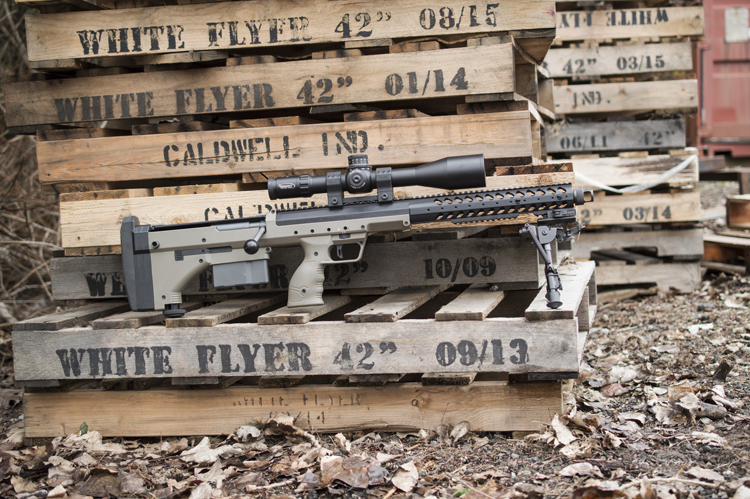
But, as handy and perfect as it is, there is one downside to the Desert Tech SRS: It’s not cheap. If you were hoping to read how we replaced our bare-bones Remington 783 package with a Desert Tech, you’re going to be disappointed. Because while the sound of our Remington bouncing off a rock might hurt, the sound of a Desert Tech such as this bouncing off a rock would probably sound almost exactly like driving a decent used car into a lake. Yup. It’d be the sound of $7500 dying. Oh, and the rifle itself is only the beginning; the caliber conversion kits (which do admittedly include everything you need) come in at almost $3,000. Magazines are $120. The muzzle brake? $350. And that lovely case that we quite like; that old thing? $800.
If those prices shock you, then you’re probably not a long range enthusiast, because in the upper echelons of that particular arena, the sky is literally the limit (long time readers will recall our testing of an Accuracy International AXMC that was roughly $22,000 as tested). But, if you are a long enthusiast that’s looking to up his game and jump into the top end of the market, the SRS is nothing short of a game changer, if for no other reason than its ability to accomplish the task at hand while being a far lighter load to carry.